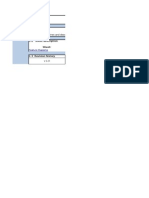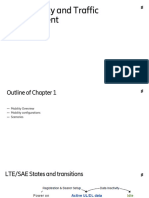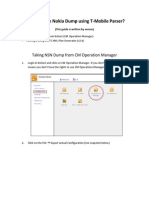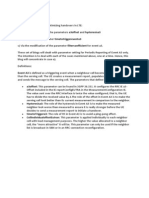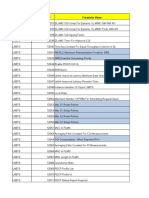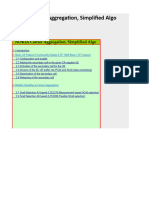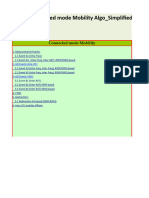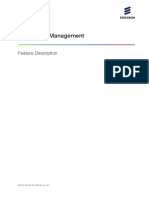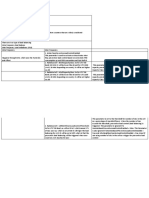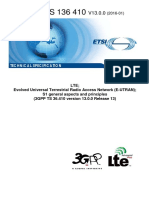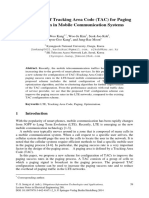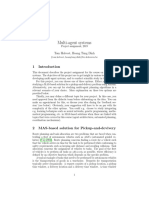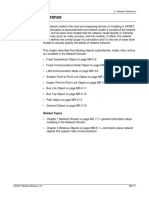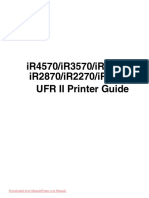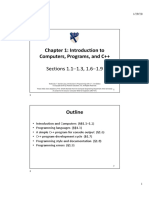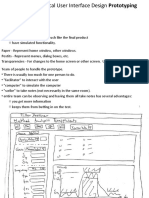25 LTE1170: Inter-eNB Inter-Frequency Load Balancing
Uploaded by
Universidad De Pamplona UP25 LTE1170: Inter-eNB Inter-Frequency Load Balancing
Uploaded by
Universidad De Pamplona UPLTE1170: Inter-eNB Inter-Frequency Load Balancing RL30, RL35 Radio Resources and Management
features
25 LTE1170: Inter-eNB Inter-Frequency Load
Balancing
25.1 Description of LTE1170: Inter-eNB Inter-Frequency
Load Balancing
Table 118 Summary of changes
Date Section Description
16.05.2018 Reference data, Activating, actInterFreqLB parameter
Deactivating MO changed.
Introduction to the feature
The LTE1170: Inter-frequency Load Balancing feature is an extension of the LTE1387:
Intra eNodeB inter-frequency Load Balancing feature. It provides the following
functionalities on top of LTE1387: Intra eNodeB inter-frequency Load Balancing:
• Inter-frequency load balancing is supported towards all frequency layers that are
used for inter-frequency eNodeB mobility as well.
• An additional load criterion is taken the PDCCH (Physical Downlink Control Channel)
load.
• There is no load information exchange over the X2 interface with other eNodeBs.
• A ”load blind” handover to reported neighbors without known CAC (composite
available capacity) according to the target cell ranking is used. If a handover
preparation fails caused by high load in the target cell, this target cell becomes
temporarily blacklisted for iF-LB handovers.
• New performance counters are introduced.
25.1.1 Benefits
End-user benefits
The load is better deployed over the network. Therefore the end user gets a higher
quality of his calls and a less call failure rate.
Operator benefits
This feature benefits the operator as follows: avoiding of overload situations for specific
cells by steering the traffic into less loaded cells at a different frequency layer or balance
load between frequency layers
25.1.2 Functional description
Functional overview
The Flexi Multiradio BTS supports load-based inter-frequency handover between
different eNodeBs connected via X2 or S1. The eNodeB monitors the source cell load to
initiate load based handovers.
The cell load calculation takes the following parameters for downlink into account:
224 © 2018 Nokia DN179911712 Issue: 01
RL30, RL35 Radio Resources and Management LTE1170: Inter-eNB Inter-Frequency Load Balancing
features
• physical resource block (PRB) used for GBR bearers
• PRBs available for non GBR users
• number of bearers with data in the buffer and their scheduling weights
• PDCCH load
All UEs changing from RRC IDLE to RRC CONNECTED become candidates for the
load-based inter-frequency handover if a UE-specific timer that is started at UE context
setup has expired and optionally when no QCI 1 bearer is established for that particular
UE.
The eNodeB triggers the load based handover if the above condition are met at expiry of
the timer. The UE capabilities are taken into account as well.
The load balancing handover is measurement-based with dedicated thresholds using the
event A4. RSRP is used as the handover trigger together with the measurements
quantities RSRP and/or RSRQ. The UE measurements are aborted if the UE does not
provide a measurement report (only if the timer expires) or only measurements reports of
temporarily blacklisted cells.
All inter-frequency target layers for the coverage-based handover are used as targets for
the load based handover. The eNodeB selects the target cell for the handover
preparation based on reported CAC, blacklisting status and RF condition. The cause
value ”reduce load at source cell”' is used for the handover preparation. The target cell
uses the CAC in addition at radio admission control thresholds to decide whether to
admit or reject a handover request with the cause value “reduce load at source cell”.
Handover preparation rejections with the cause value “Radio Network Layer Cause” or
“Transport Layer Cause” will be used to temporarily blacklist the concerned cell for a load
based handover. The blacklisting timer is operator configurable. Handover preparation
rejection does not terminate load balancing for this UE. Preparation with the next target
cell will be performed. Handover retries are not performed (i.e. neither after a handover
request due to load balancing has been rejected nor when a load balancing handover
was not successful).
Separate performance counters are provided in order to capture the hand overs because
of load balancing.
Comparison to LTE1387: Intra eNodeB Inter-frequency Load Balancing
The LTE1170: Inter-frequency Load balancing feature provides on top of the LTE1387:
Intra eNodeB Inter-frequency Load Balancing feature:
Table 119 Comparison to LTE1387: Intra-eNodeB IF Load Balancing
Functional Block LTE1387 IF-LB Specific LTE1170 Delta
Functionalities Functionalities (on top of
LTE1387)
Frequency Layer Used for IF- only frequency layers which All frequency layers which are
LB (Inter Frequency Load are supported by the eNodeB used for E-UTRA inter-
Balancing) (intra eNodeB cells only) frequency mobility HO (intra
and inter eNodeB cells
possible)
DN179911712 Issue: 01 © 2018 Nokia 225
LTE1170: Inter-eNB Inter-Frequency Load Balancing RL30, RL35 Radio Resources and Management
features
Table 119 Comparison to LTE1387: Intra-eNodeB IF Load Balancing (Cont.)
Functional Block LTE1387 IF-LB Specific LTE1170 Delta
Functionalities Functionalities (on top of
LTE1387)
Measured load types GBRdl, nonGBRdl PDCCH (inclusive 2
thresholds - target/ high load)
Load exchange between only eNodeB internal Nothing changed for eNodeB
neighbor cells exchange internal cells. No load
exchange with other eNodeBs
(no X2 procedure for this).
Start/Stop High Load Status Start: At least one load type's Additional load type PDCCH
(Entry/Exit Active IF-LB state) actual load exceeds the
related high load
threshold.Stop: All load types
actual loads are (again) below
target threshold.
Candidate UE selection (in Trigger: UE does idle --> nothing on top
case of high load status of active transition and fulfills
own cell) some more conditions (all
what is needed for
interfrequency HOs)
Measurement Solicitation A4 report with minimum For all frequency layers which
threshold ttt + postprocessing are used for mobility HO
of reported RSRP/RSRQ
values
Target Cell Selection Target cells from A4 report Cells from any eNodeB. If
with RSRP/RSRQ > iF-LB neighbor cell CAC is not
thresholds and CAC > 0 which known, the related cells are
are supported from own ranked lowest. A “load blind”
eNodeB. Ranking criterion HO to reported neighbors
CAC. without known valid CAC
according to target cell
ranking is possible. If any iF-
LB HO preparation fails (for
any “lack of resources” reject
reason) the target cell is
blacklisted temporarily for LB-
HOs. Blacklisting is done just
in the actual source cell and
NOT in all cells of the
eNodeB!
LB HO regular HO with cause nothing on top
"Reduce Load in Serving Cell"
Performance Counter none • Number of load balancing
Handover attempts
226 © 2018 Nokia DN179911712 Issue: 01
RL30, RL35 Radio Resources and Management LTE1170: Inter-eNB Inter-Frequency Load Balancing
features
Table 119 Comparison to LTE1387: Intra-eNodeB IF Load Balancing (Cont.)
Functional Block LTE1387 IF-LB Specific LTE1170 Delta
Functionalities Functionalities (on top of
LTE1387)
• Number of successful
load balancing Handover
completions
• High cell load Indicator for
Load Balancing
RAC RAC transports load RACin addition to the already
measurements from performed threshold checks
Scheduler to higher layer considers the actual CAC of
(load types: GBRdl, the cell. If CAC=0 the HO
nonGBRdl) preparation is
rejected.Additional load type:
PDCCH
25.1.3 System impact
Interdependencies between features
LTE55: Inter-frequency handover is a prerequisite for LTE1387: Intra eNodeB inter-
frequency load balancing and LTE1170: Inter-frequency load balancing.
LTE1387: Intra eNodeB inter-frequency balancing: this is the basis for the iF-LB
functionality. LTE1170: Inter-frequency load balancing comprises some add-ons that
work only together with the basis functionality.
Impact on interfaces
This feature has no impact on interfaces.
Impact on network and network element management tools
This feature has no impact on network management or network element management
tools.
Impact on system performance and capacity
No particular overall impact on system performance is expected. If cells are in active
load balancing status, the handover rate will slightly increase.
Depending on the parameter settings and traffic load, the average RAN network capacity
might be increased, as the UEs are moved from high loaded cells to other cells and
frequency layers (inter-eNB load balancing). There is no impact on the eNB system
capacity or single cell capacity as such.
DN179911712 Issue: 01 © 2018 Nokia 227
LTE1170: Inter-eNB Inter-Frequency Load Balancing RL30, RL35 Radio Resources and Management
features
25.2 LTE1170 reference data
LTE1170: Inter-eNB Inter-Frequency Load Balancing requirements, alarms and faults,
commands, measurements and counters, KPIs, parameters, and sales information
Requirements
Table 120 LTE1170 hardware and software requirements
FDD TDD
System release RL50 RL35
Flexi Multiradio 10 BTS LBTS5.0 TD-LBTS3.0
Flexi Multiradio 10 Indoor BTS Not supported Not supported
Nokia AirScale BTS FL16A TL16A
Flexi Zone BTS LBTSFZ5.0 TD-LBTS5.0
Flexi Zone Access Point FL15A TL15A
Cloud Flexi Zone Controller FL17A TL17A
OMS Support not required Support not required
NetAct Support not required Support not required
MME Support not required Support not required
SAE GW Support not required Support not required
UE 3GPP R8 UE capabilities 3GPP R8 UE capabilities
Alarms
There are no alarms related to the LTE1170: Inter-Frequency Load Balancing
management data feature.
BTS faults and reported alarms
There are no faults related to the LTE1170: Inter-Frequency Load Balancing
management data feature.
Commands
There are no commands related to the LTE1170: Inter-Frequency Load Balancing
management data feature.
Measurements and counters
Table 121 New counters introduced by LTE1170
Counter Counter name Measurement
ID
M8011C High cell load indicator for LTE Cell Resource
69 load balancing
M8021C Number of load balancing LTE Handover
23 Handover attempts
228 © 2018 Nokia DN179911712 Issue: 01
RL30, RL35 Radio Resources and Management LTE1170: Inter-eNB Inter-Frequency Load Balancing
features
Table 121 New counters introduced by LTE1170 (Cont.)
Counter Counter name Measurement
ID
M8021C Number of successful load LTE Handover
24 balancing Handover
completions
For counter descriptions, see Reference documentation.
Key performance indicators
There are no key performance indicators related to the LTE1170: Inter-eNB Inter-
Frequency Load Balancing feature.
Parameters
Table 122 New parameters introduced by LTE1170
Full name Abbreviated name Managed Parent FDD/TDD
object structure
Enable actIfHo LNBTS - common
interFrequency
Handover
Activation of actInterFreqLB LNCEL - common
inter-frequency
load balancing
(iFLB)
Prohibit Load based prohibitLBHOTi LNBTS - common
handover timer mer
Inter-frequency iFLBLoadThresh LNCEL - common
load balancing load olds
thresholds
Inter-frequency iFLBBearCheckT LNCEL iFLBLoadThr common
load balancing QCI1 imer esholds
Bearer check timer
Inter-frequency iFLBHighLoadGB LNCEL iFLBLoadThr common
load balancing GBR RDL esholds
high load DL
Inter-frequency iFLBHighLoadNo LNCEL iFLBLoadThr common
load balancing non- nGBRDL esholds
GBR high load DL
Inter-frequency iFLBHighLoadPd LNCEL iFLBLoadThr common
load balancing cch esholds
PDCCH high load
Inter Freq Load Bal iFLBRetryTimer LNCEL iFLBLoadThr common
Retry Timer esholds
Inter-freq load bal thresholdRsrpI LNHOIF - common
threshold for RSRP FLBFilter
target filter
Load filtering lbLoadFilCoeff LNCEL - common
coefficient
DN179911712 Issue: 01 © 2018 Nokia 229
LTE1170: Inter-eNB Inter-Frequency Load Balancing RL30, RL35 Radio Resources and Management
features
Table 122 New parameters introduced by LTE1170 (Cont.)
Full name Abbreviated name Managed Parent FDD/TDD
object structure
Intra- and inter- loadSettings LNCEL - common
freq. load bal.
common load
settings
Cell capacity class cellCapClass LNCEL loadSetting common
value s
Mode for mlbEicicOperMo LNCEL loadSetting common
calculating the CAC de s
in load bal. and
eICIC
Nominal number of nomNumPrbNonGb LNCEL loadSetting common
PRBs for load r s
balancing
DL GBR resource targetLoadGbrD LNCEL loadSetting common
target load l s
DL non-GBR resource targetLoadNonG LNCEL loadSetting common
target load brDl s
PDCCH target load targetLoadPdcc LNCEL loadSetting common
h s
Uplink CAC source ulCacSelection LNCEL loadSetting common
selection s
Static CAC for ulStaticCac LNCEL loadSetting common
uplink s
For parameter descriptions, see Reference documentation.
Sales information
Table 123 LTE1170 sales information
Product structure class License control Activated by default
ASW SW Asset Monitoring No
25.3 Activating LTE1170: Inter-eNB Inter-Frequency
Load Balancing
Before you start
Restart of the eNB is not required after activation of this feature.
The Activation of inter-frequency load balancing
(iFLB)(actInterFreqLB) parameter is used to activate the feature.
g Note: The Activation of inter-frequency load balancing
(iFLB)(actInterFreqLB) parameter activates at the same time the
LTE1387: Intra-eNodeB Inter-frequency Load Balancing feature.
230 © 2018 Nokia DN179911712 Issue: 01
RL30, RL35 Radio Resources and Management LTE1170: Inter-eNB Inter-Frequency Load Balancing
features
The following parameters are used to perform an additional configuration of the feature:
• Inter-frequency load balancing load
thresholds (iFLBLoadThresholds)
• Intra- and inter-freq. load bal. common load
settings (loadSettings)
• Inter-freq load bal threshold for RSRP target
filter (thresholdRsrpIFLBFilter)
• Prohibit Load based handover timer (prohibitLBHOTimer)
The LTE55: Inter-frequency Handover feature needs to be activated/configured before
activation of the LTE1170: Inter-frequency Load Balancing feature.
Steps
1 Follow the general procedure described in section Activating and deactivating LTE
features using BTS Site Manager.
In Step 3 (Modify the feature-specific eNB configuration settings) of the general
procedure perform the steps described in this procedure.
2 Go to the Radio Network Configuration page.
a) Expand the MRBTS object.
b) Select the LNBTS object.
c) Select the LNCEL object.
d) Set the Activation of inter-frequency load balancing (iFLB)
(actInterFreqLB) parameter value to true.
g Note: This parameter activates the feature.
3 Define Inter-frequency load balancing load thresholds
(iFLBLoadThresholds)
a) Expand the MRBTS object.
b) Expand the LNBTS object where the LTE1170: Inter-frequency Load Balancing
feature is being activated.
c) In each LNCEL object under selected LNBTS, repeat the following actions:
1. If the Inter-frequency load balancing load thresholds object is not
available under LNCEL, right-click on the LNCEL object and select New
Inter-frequency load balancing load thresholds.
2. Expand Inter-frequency load balancing load thresholds under LNCEL
object.
3. Select Inter-frequency load balancing load thresholds-1 and define all the
parameters within this object.
DN179911712 Issue: 01 © 2018 Nokia 231
LTE1170: Inter-eNB Inter-Frequency Load Balancing RL30, RL35 Radio Resources and Management
features
g Note: This action is optional because the
Inter-frequency load balancing load
thresholds (iFLBLoadThresholds) parameters’ structure has default
values set during the object creation. The modification of the default values is not
mandatory.
4 Define Intra- and inter-freq. load bal. common load settings (loadSettings)
a) Expand the MRBTS object.
b) Expand the LNBTS object where the LTE1170: Inter-frequency Load Balancing
feature is being activated.
c) In each LNCEL object under selected LNBTS, repeat the following actions:
1. If the Intra- and inter-freq. load bal. common load settings object is not
available under LNCEL, right-click on the LNCEL object and select New
Intra- and inter-freq. load bal. common load settings.
2. Expand Intra- and inter-freq. load bal. common load settings under
LNCEL object.
3. Select Intra- and inter-freq. load bal. common load settings-1 and define
all the parameters within this object.
g Note: This action is optional because the
Intra- and inter-freq. load bal. common load
settings (loadSettings) parameters’ structure has default values set
during the object creation. The modification of the default values is not
mandatory.
5 Define RSRP target filters (optional)
Sub-steps
a)
Expand the MRBTS object.
b) Expand the LNBTS object where the LTE1170: Inter-frequency Load Balancing
feature is being activated.
c)
In each LNHOIF object that belongs to LNBTS where the LTE1170: Inter-
frequency Load Balancing feature is being activated, set the Inter-freq
load bal threshold for RSRQ target
filter (thresholdRsrqIFLBFilter) or the Inter-freq load bal
threshold for RSRP target filter (thresholdRsrpIFLBFilter)
parameter.
g Note: The RSRP/RSRQ filters have predefined default values that can be used.
232 © 2018 Nokia DN179911712 Issue: 01
RL30, RL35 Radio Resources and Management LTE1170: Inter-eNB Inter-Frequency Load Balancing
features
25.4 Deactivating LTE1170: Inter-eNB Inter-Frequency
Load Balancing
Before you start
Restart of the eNB is not required after activation of this feature.
The Activation of inter-frequency load balancing(iFLB)
(actInterFreqLB) parameter is used to deactivate the feature.
g Note: When the
Activation of inter-frequency load balancing(iFLB)
(actInterFreqLB) parameter is set to false, it deactivates also the
LTE1387: Intra-eNodeB Inter-frequency Load Balancing feature.
Steps
1 Follow the general procedure described in section Activating and deactivating LTE
features using BTS Site Manager.
In Step 3 (Modify the feature-specific eNB configuration settings) of the general
procedure perform the steps described in this procedure.
2 Go to the Radio Network Configuration page.
a) Expand the MRBTS object.
b) Select the LNBTS object.
c) Select the LNCEL object.
d) Set the Activation of inter-frequency load balancing
(iFLB)(actInterFreqLB) parameter value to false.
g Note: This parameter deactivates the feature.
DN179911712 Issue: 01 © 2018 Nokia 233
You might also like
- LTE Radio Parameters 1 (FL16a) Connected Mode Mobility: © Nokia 2016 RA4121BEN16aGLA0No ratings yetLTE Radio Parameters 1 (FL16a) Connected Mode Mobility: © Nokia 2016 RA4121BEN16aGLA043 pages
- LTE Report Set - RSLTE LTE16A (Published)No ratings yetLTE Report Set - RSLTE LTE16A (Published)79 pages
- Nokia Mass Event Optimization White Paper en100% (1)Nokia Mass Event Optimization White Paper en17 pages
- Uplink Carrier Aggregation: Feature DescriptionNo ratings yetUplink Carrier Aggregation: Feature Description37 pages
- 3G Network Controlled Fast Dormancy": Implementation As One Alternative Solution For High Penetration SmartphoneNo ratings yet3G Network Controlled Fast Dormancy": Implementation As One Alternative Solution For High Penetration Smartphone15 pages
- Reference Signal Power Boosting in LTE (Pa & PB)100% (4)Reference Signal Power Boosting in LTE (Pa & PB)2 pages
- Lte High Capacity Event Parameters - Ericsson0% (1)Lte High Capacity Event Parameters - Ericsson27 pages
- FR/HR Traffic Balance FRL/FRU AFRL/AFRU: 3. Push More Traffic at 180050% (2)FR/HR Traffic Balance FRL/FRU AFRL/AFRU: 3. Push More Traffic at 18003 pages
- LTE Radio Link Failure and RRC Re-establishment100% (3)LTE Radio Link Failure and RRC Re-establishment65 pages
- Nokia 2G Parameters: Prepared by Nishant Gaurav 1100% (1)Nokia 2G Parameters: Prepared by Nishant Gaurav 122 pages
- NOKIA Carrier Aggregation, Simplified AlgoNo ratings yetNOKIA Carrier Aggregation, Simplified Algo32 pages
- NOKIA Connected Mode Mobility Algo - SimplifiedNo ratings yetNOKIA Connected Mode Mobility Algo - Simplified27 pages
- Nokia LTE Counters and KPI Performance Management Latest SW - Chennai50% (2)Nokia LTE Counters and KPI Performance Management Latest SW - Chennai3 pages
- Nokia Feature Description RL70-Intra Freq LB0% (1)Nokia Feature Description RL70-Intra Freq LB8 pages
- 3.4 L TE1140: Intra-Frequen Cy Load Balancin GNo ratings yet3.4 L TE1140: Intra-Frequen Cy Load Balancin G8 pages
- IFLB - 83 - 22104-Lza7016014 - 1uen - cb12bNo ratings yetIFLB - 83 - 22104-Lza7016014 - 1uen - cb12b57 pages
- 05 LR13.3 ORF Workshop Proposed Validation Strategy For Load Balancing FeaturesNo ratings yet05 LR13.3 ORF Workshop Proposed Validation Strategy For Load Balancing Features19 pages
- SPD - eRAN7.0 MLB Feature Introduction-20140228-A-1.0No ratings yetSPD - eRAN7.0 MLB Feature Introduction-20140228-A-1.026 pages
- CN-id: RSLTE - RL60 - 813: Operations Support SystemsNo ratings yetCN-id: RSLTE - RL60 - 813: Operations Support Systems22 pages
- Etsi Ts 1 136 410: Technical Specification IONNo ratings yetEtsi Ts 1 136 410: Technical Specification ION17 pages
- Configuration of Tracking Area Code (TAC) For Paging Optimization in Mobile Communication SystemsNo ratings yetConfiguration of Tracking Area Code (TAC) For Paging Optimization in Mobile Communication Systems2 pages
- IBM System Storage N Series N6210 and N6240 Offer Enterprise-Class Fibre Channel, iSCSI, and NAS Storage With Gateway OptionsNo ratings yetIBM System Storage N Series N6210 and N6240 Offer Enterprise-Class Fibre Channel, iSCSI, and NAS Storage With Gateway Options40 pages
- Pui Lam Paul Lo - Senior Software Developer - HANo ratings yetPui Lam Paul Lo - Senior Software Developer - HA3 pages
- Multi-Agent Systems: Tom Holvoet, Hoang Tung DinhNo ratings yetMulti-Agent Systems: Tom Holvoet, Hoang Tung Dinh4 pages
- Smartphones For Dummies: (10 Things To Do On Your New Nokia 6630 or Nokia 6680)No ratings yetSmartphones For Dummies: (10 Things To Do On Your New Nokia 6630 or Nokia 6680)4 pages
- Computer Organization and Architecture 8 EditionNo ratings yetComputer Organization and Architecture 8 Edition15 pages
- Oracle FUsion Application New Oracle Cloud ConsoleNo ratings yetOracle FUsion Application New Oracle Cloud Console5 pages
- CPSC 1105 Assignment 2 Template 1 - 1687663454447No ratings yetCPSC 1105 Assignment 2 Template 1 - 16876634544472 pages
- Chapter 1: Introduction To Computers, Programs, and C++: Sections 1.1-1.3, 1.6-1.9No ratings yetChapter 1: Introduction To Computers, Programs, and C++: Sections 1.1-1.3, 1.6-1.9298 pages
- ENG6500 8 DL IntroductionToDeepLearning Part2No ratings yetENG6500 8 DL IntroductionToDeepLearning Part265 pages
- Smart Home Using IOT Integrated With Cloud: November 2016No ratings yetSmart Home Using IOT Integrated With Cloud: November 201630 pages
- Real 2 Tower Indoor DAS - Neutral Host Proposal: /nfrastructureNo ratings yetReal 2 Tower Indoor DAS - Neutral Host Proposal: /nfrastructure12 pages






